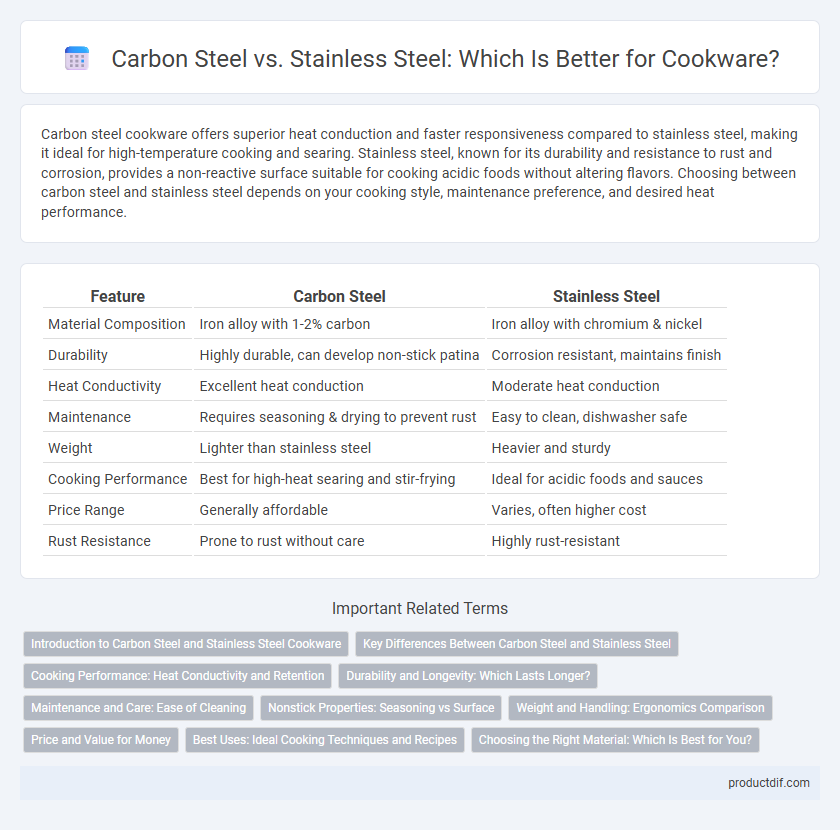Carbon steel cookware offers superior heat conduction and faster responsiveness compared to stainless steel, making it ideal for high-temperature cooking and searing. Stainless steel, known for its durability and resistance to rust and corrosion, provides a non-reactive surface suitable for cooking acidic foods without altering flavors. Choosing between carbon steel and stainless steel depends on your cooking style, maintenance preference, and desired heat performance.
Table of Comparison
| Feature | Carbon Steel | Stainless Steel |
|---|---|---|
| Material Composition | Iron alloy with 1-2% carbon | Iron alloy with chromium & nickel |
| Durability | Highly durable, can develop non-stick patina | Corrosion resistant, maintains finish |
| Heat Conductivity | Excellent heat conduction | Moderate heat conduction |
| Maintenance | Requires seasoning & drying to prevent rust | Easy to clean, dishwasher safe |
| Weight | Lighter than stainless steel | Heavier and sturdy |
| Cooking Performance | Best for high-heat searing and stir-frying | Ideal for acidic foods and sauces |
| Price Range | Generally affordable | Varies, often higher cost |
| Rust Resistance | Prone to rust without care | Highly rust-resistant |
Introduction to Carbon Steel and Stainless Steel Cookware
Carbon steel cookware offers excellent heat conductivity and durability, making it ideal for high-heat cooking techniques like searing and stir-frying. Stainless steel cookware resists rust and corrosion, providing a non-reactive surface perfect for cooking acidic foods and everyday use. Both materials are favored by chefs for their versatility, with carbon steel requiring seasoning for a natural non-stick layer and stainless steel known for its low maintenance and long-lasting shine.
Key Differences Between Carbon Steel and Stainless Steel
Carbon steel cookware offers superior heat conductivity and responsiveness, making it ideal for high-heat cooking and searing, while stainless steel excels in corrosion resistance and durability due to its chromium content. Carbon steel requires seasoning to maintain a non-stick surface and prevent rust, whereas stainless steel is low-maintenance and dishwasher safe. The choice depends on cooking style, with carbon steel favored for precision heat control and stainless steel for easy maintenance and versatility.
Cooking Performance: Heat Conductivity and Retention
Carbon steel cookware offers superior heat conductivity and faster responsiveness, making it ideal for searing and high-heat cooking. Stainless steel excels in heat retention, providing even and consistent cooking temperatures essential for simmering and slow-cooking tasks. Both materials deliver distinct advantages: carbon steel rapidly adjusts to temperature changes, while stainless steel maintains steady heat over prolonged cooking periods.
Durability and Longevity: Which Lasts Longer?
Carbon steel cookware offers exceptional durability due to its ability to withstand high temperatures and resist warping, often lasting decades with proper seasoning and maintenance. Stainless steel is highly resistant to rust, corrosion, and staining, making it a long-lasting option that requires less maintenance compared to carbon steel. While carbon steel may develop a natural non-stick patina over time, stainless steel maintains its original finish, providing reliable longevity in professional and home kitchens.
Maintenance and Care: Ease of Cleaning
Carbon steel cookware requires seasoning to maintain its non-stick properties and prevent rust, demanding regular oiling and thorough drying after each use. Stainless steel is easier to clean due to its rust-resistant surface and dishwasher compatibility, allowing for more straightforward maintenance. Both materials benefit from avoiding abrasive scrubbers to preserve their surface quality and extend cookware lifespan.
Nonstick Properties: Seasoning vs Surface
Carbon steel cookware develops natural nonstick properties through seasoning, creating a durable, polymerized oil layer that improves with use. Stainless steel lacks this seasoning capability and relies on a smooth, polished surface to prevent food from sticking. Proper preheating and oiling techniques are essential for both materials to maximize their nonstick performance during cooking.
Weight and Handling: Ergonomics Comparison
Carbon steel cookware is lighter, offering superior maneuverability and ease of handling, which benefits tasks requiring quick wrist movements and precise control. Stainless steel tends to be heavier, providing a more substantial feel that can enhance stability but may cause fatigue during prolonged use. The ergonomic advantage of carbon steel supports professional chefs and home cooks seeking agility, while stainless steel favors those prioritizing durability and balance in heavier cookware.
Price and Value for Money
Carbon steel cookware generally offers better value for money due to its lower price and excellent heat conductivity, making it ideal for professional and home cooks seeking performance without high costs. Stainless steel, while pricier, provides superior durability, corrosion resistance, and ease of maintenance, justifying its cost for those prioritizing longevity and minimal upkeep. Both materials deliver distinct advantages, but carbon steel stands out in affordability and cooking efficiency.
Best Uses: Ideal Cooking Techniques and Recipes
Carbon steel cookware excels in high-heat cooking methods like searing, frying, and stir-frying due to its superior heat retention and quick responsiveness. Stainless steel is ideal for tasks requiring even heat distribution and non-reactive surfaces, such as simmering sauces, boiling water, and preparing acidic dishes like tomato-based recipes. Both materials perform well in the oven, but carbon steel's ability to develop a natural non-stick patina makes it perfect for techniques like pan-frying and sauteing delicate proteins.
Choosing the Right Material: Which Is Best for You?
Carbon steel cookware offers superior heat conductivity and excellent seasoning capabilities, making it ideal for high-heat cooking and developing non-stick surfaces over time. Stainless steel provides exceptional durability, resistance to rust and corrosion, and maintains a polished appearance, suitable for acidic dishes and easy maintenance. Selecting between carbon steel and stainless steel depends on your cooking style, with carbon steel excelling in searing and browning, while stainless steel offers versatility and low upkeep.
Carbon Steel vs Stainless Steel Infographic

 productdif.com
productdif.com